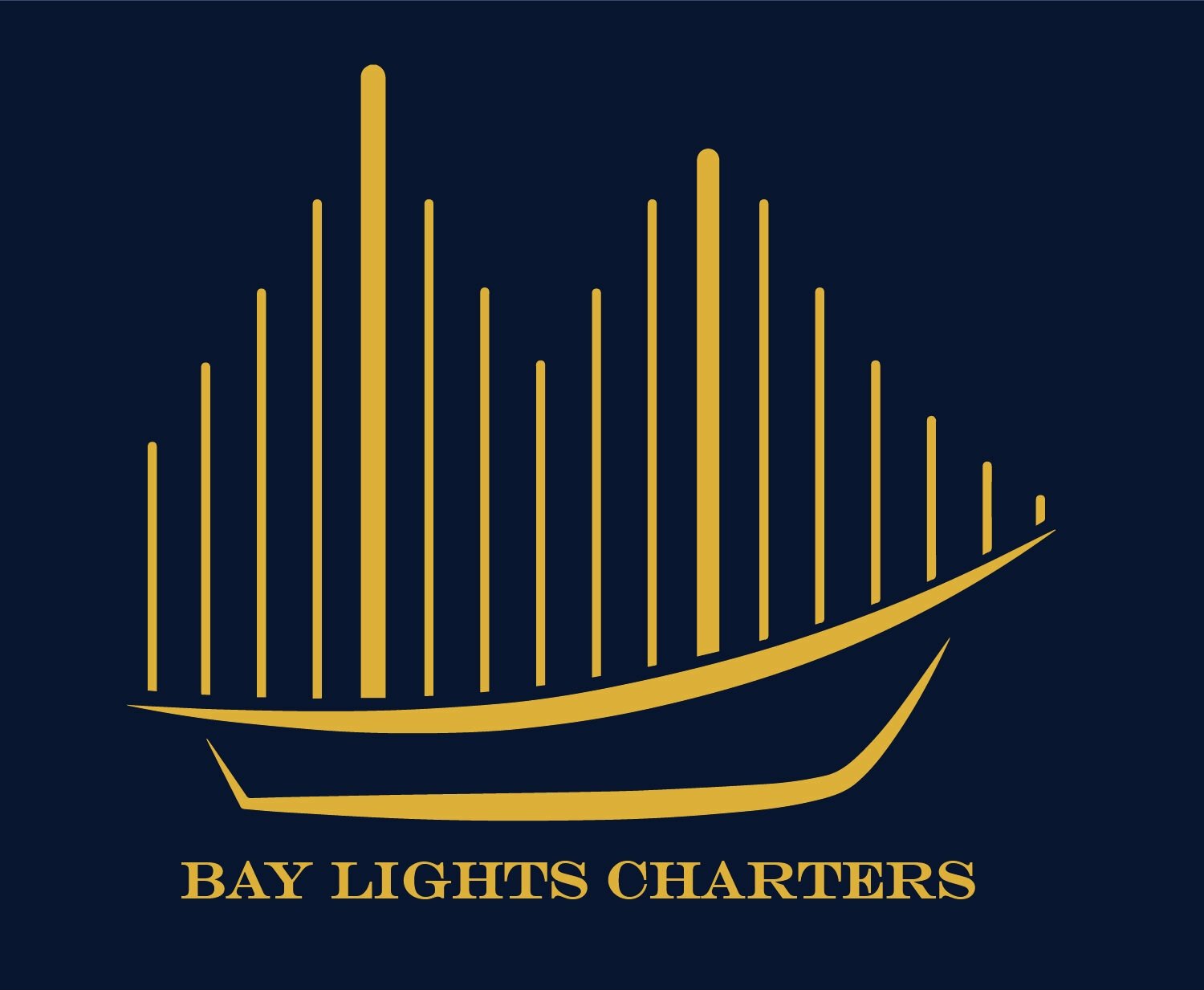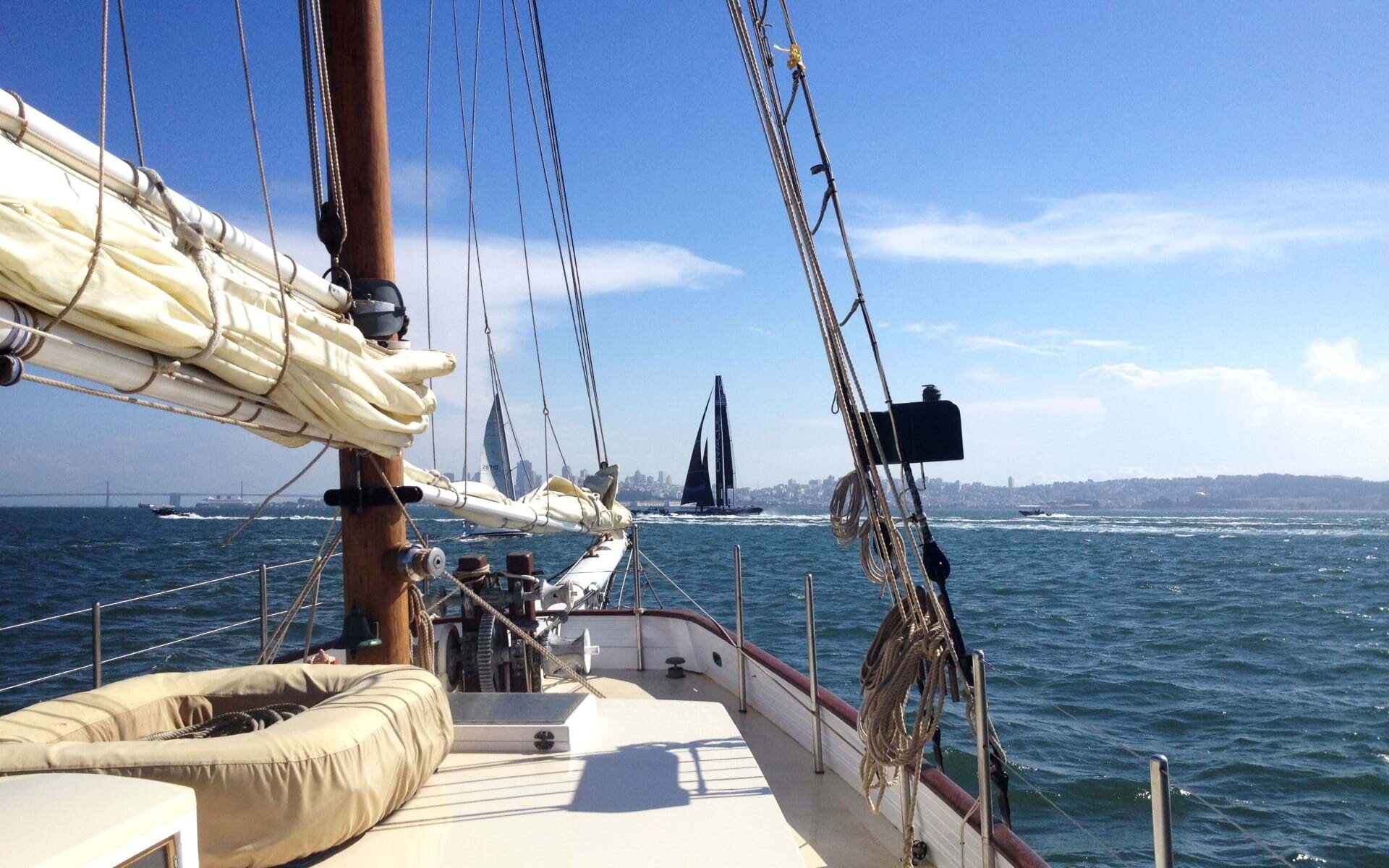The History of Gas Light, how she came to sail SF Bay
Our vessel Gas Light is very unique considering her history in San Francisco Bay…. spanning over 150 years.
Her dimensions and design tell her amazing story.
First, she is built of modern materials. A strong, solid steel hull and rudder take the place of traditional wooden construction. She is very wide for her length. Her wide hull translates to a very spacious interior which most sailing vessels, especially charter vessels do not have. Easy access to her large cabin with only 4 wide steps down is a big plus.
Gas Light's schooner rig refers to her 2 masts and slightly shorter forward mast. The boat's traditional rigging allows her guests on any charter to participate by raising the sails with muscle power the way it was done in the mid 1800's.
Gas Light has a 'scow' shaped hull, or body. This design is characteristic of very flat sides and forward sections above the waterline. The bottom is very flat meaning the stability under sail is very good. No other charter sailing boat can offer the same flat, stable and comfortable ride while navigating the sometimes choppy Bay. This translates to your beverage glasses and food plates staying where you place them....much like on land!
Gas Light's beauty is legendary. Our recent upgrades have showcased her stunning wood interior and solid wooden Douglas Fir masts. The original builder, Billy Martinelli spent years completing the woodwork that stands out everywhere. We have maintained her impeccably and now, more than ever, she is ready for you to enjoy during any event under sail on San Francisco Bay.
Hi, everybody. Captain Steve, here! I am aboard our Scow Schooner Gas Light here on San Francisco Bay. I'd like to talk to you a little bit about the vessel ‘Gas Light’ today and her unique design and features.
Gaslight is a schooner rigged sailing vessel. The “rig” of the vessel refers to her masts and sail configuration. A schooner rig means she has a forward mast which is just slightly shorter than her aft, or main mast.
The “scow” design describes the very flat forward sections and bottom of Gas Lights hull. When these two positive attributes are combined (the schooner rig and scow shaped hull), you have a type of vessel was very unique to the San Francisco Bay Area. Beginning around 1850, the scow schooner was the 18 wheeler of the day. There was actually a vessel named ‘Gas Light’ built in 1874 nearly the exact dimensions of our Gas Light. Today, our modern vessel is built using solid 1/4 inch steel.
Due to her scow design, she sails extremely flat and she's very stable even in the higher winds of San Francisco Bay that we see during the summer months. So, even though we're cruising along, moving along very swiftly through the water, she's very efficient under sail and she sails very flat because of that unique design.
This stable design was vitally important to the emerging economy of California in the mid-1800’s. Over 600 of these vessels just like Gas Light hauled everything from bricks to lumber to oyster shells all over San Francisco Bay and the vast California Delta. This design has a unique history and direct importance to San Francisco, its maritime history and its economic growth for over 100 years.
Gas Light offers some very unique features on board the vessel for the passengers. One of the most obvious is her beautiful wide side decks and the fact that there's plenty of comfortable seating both above decks and below.
When you first step below, you will see wood working at its finest. The yellow cedar, red cedar, the solid 15 foot center mahogany table all feel warm, inviting and give the sense of a “speak-easy” environment from the 1920’s. Gas Light’s interior is very spacious with wide open areas to walk to and from the full bar to a comfortable couch to enjoy a beverage while underway. We have recently added a second restroom to accommodate our guests. Gas Light’s interior is truly one-of-a-kind in the charter boat fleet and the envy of her competitors.
During a typical cruise, Gas Light sails very flat, so food service on the boat and beverage service on the boat is like no other boat on the bay, at least no other sailboat. Her stability is legendary as we've talked about, creating a platform for her guests that is more like being in a land based restaurant yet zooming along under full sail!
Above deck, you might first notice the huge solid masts towering nearly 80’ in the sky. The builder hand-picked them from Mendocino County of California. Her complicated rigging of many hundreds of feet of ropes, wire, cable and line form a complex sight that our experienced crew has learned from years of operating her sails over thousands of miles underway with passengers.
Underneath the water, she has a center board. She does not have a fixed keel as most sailing vessels. The center board makes her very unique as well in the sense that we can pull the center board up and float in only three and a half feet of water! When we're under sail, we lower the center board down and she draws about seven and a half feet. Again, a very unique feature designed for the early days of freight carriage, yet perfect for modern-day use. All of her ballast to counter-act the wind forces is carried inside her hull.
So, Gas Light, in addition to her being unique in design to San Francisco Bay, was also built here locally in Sausalito. Her original builder and owner began construction in 1990. The hull was finished in 1998 and she was Coast Guard certified in 2000 to carry 49 passengers and 5 crew.
Today, we offer cruises year round. We operate Gas Light out of three general locations here in San Francisco Bay. Out of Richmond, Marina Bay, Sausalito, as well as Pier 40 in downtown San Francisco on the Embarcadero. Gas Light is available for Charter 12 months of the year, and we're happy to offer her for many different types of events.
We are very proud of Gas Light’s heritage, her fantastic style and sailing ability for her guests. Come and experience a part of California’s and America’s history in a whole new way!

